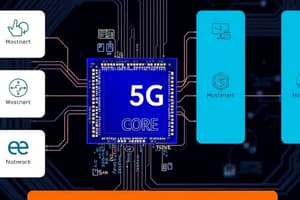Podcast
Questions and Answers
Within a 5G core network employing network function virtualization (NFV), what critical role does the software-defined networking (SDN) controller perform beyond simply assigning IP addresses to new virtual network functions (VNFs)?
Within a 5G core network employing network function virtualization (NFV), what critical role does the software-defined networking (SDN) controller perform beyond simply assigning IP addresses to new virtual network functions (VNFs)?
- It independently manages and scales the underlying hardware resources, optimizing energy consumption and minimizing physical footprint in data centers.
- It dynamically adjusts the quality of service (QoS) parameters for each VNF based on real-time traffic analysis and predefined service level agreements (SLAs).
- It provides enhanced security by implementing intrusion detection and prevention systems (IDPS) at the VNF level, mitigating potential threats and vulnerabilities.
- It centrally orchestrates the entire network by managing bandwidth allocation, forwarding logic, and IP address assignment, ensuring seamless integration of new VNFs. (correct)
Purpose-built hardware in telecommunications networks offers greater flexibility and resource utilization compared to generic hardware managed by network function virtualization (NFV).
Purpose-built hardware in telecommunications networks offers greater flexibility and resource utilization compared to generic hardware managed by network function virtualization (NFV).
False (B)
Elaborate on the significance of decoupling functions from hardware in the context of Network Function Virtualization (NFV), detailing at least two key benefits this separation provides to network operators.
Elaborate on the significance of decoupling functions from hardware in the context of Network Function Virtualization (NFV), detailing at least two key benefits this separation provides to network operators.
NFV enables network operators to achieve greater agility and cost-efficiency by separating software functions from dedicated hardware. This separation allows for dynamic resource allocation, reducing capital expenditure (CAPEX) and operational expenditure (OPEX), and faster deployment of new services.
In the context of network evolution towards 5G, the transition from fixed capacity to __________ capacity addresses the need for dynamic resource allocation and scalability.
In the context of network evolution towards 5G, the transition from fixed capacity to __________ capacity addresses the need for dynamic resource allocation and scalability.
Match the following network elements/functions with their descriptions in a virtualized 5G core network:
Match the following network elements/functions with their descriptions in a virtualized 5G core network:
Within the architectural framework of Network Function Virtualization (NFV), which layer is primarily responsible for abstracting the underlying hardware resources and providing a unified interface for Virtual Network Functions (VNFs)?
Within the architectural framework of Network Function Virtualization (NFV), which layer is primarily responsible for abstracting the underlying hardware resources and providing a unified interface for Virtual Network Functions (VNFs)?
Cloud-native network architectures inherently eliminate the need for any form of network administrator, as automation and orchestration tools autonomously manage all aspects of network operations.
Cloud-native network architectures inherently eliminate the need for any form of network administrator, as automation and orchestration tools autonomously manage all aspects of network operations.
What is the challenge SDN addresses regarding network functions created quickly using NFV?
What is the challenge SDN addresses regarding network functions created quickly using NFV?
In the context of 5G core network evolution, the shift from operation expenditure (OPEX) in NFV aims to reduce the reliance on costly, dedicated resources, leading to a more efficient and scalable network infrastructure.
In the context of 5G core network evolution, the shift from operation expenditure (OPEX) in NFV aims to reduce the reliance on costly, dedicated resources, leading to a more efficient and scalable network infrastructure.
Match the following concepts related to 5G core network virtualization with their corresponding descriptions:
Match the following concepts related to 5G core network virtualization with their corresponding descriptions:
In a 5G core network leveraging network function virtualization (NFV), what is the primary benefit of transitioning from purpose-built hardware to generic hardware?
In a 5G core network leveraging network function virtualization (NFV), what is the primary benefit of transitioning from purpose-built hardware to generic hardware?
In the context of 5G core network virtualization, the terms 'network element' and 'network function' are interchangeable and refer to the same entity.
In the context of 5G core network virtualization, the terms 'network element' and 'network function' are interchangeable and refer to the same entity.
Explain the dual role SDN plays with both user plane and control plane in network traffic forwarding.
Explain the dual role SDN plays with both user plane and control plane in network traffic forwarding.
In the 5G network, the traditional approach of allocating dedicated hardware resources to functions is replaced by the paradigm of _______, where resources are pooled and dynamically allocated as needed.
In the 5G network, the traditional approach of allocating dedicated hardware resources to functions is replaced by the paradigm of _______, where resources are pooled and dynamically allocated as needed.
Match each term related to 5G core network architecture with its correct description:
Match each term related to 5G core network architecture with its correct description:
In the context of network slicing within a 5G core network, what is the primary function of the Operations Support System (OSS) in managing virtualized network functions (VNFs)?
In the context of network slicing within a 5G core network, what is the primary function of the Operations Support System (OSS) in managing virtualized network functions (VNFs)?
Software-defined networking (SDN) primarily focuses on virtualizing network functions, while network function virtualization (NFV) concentrates on centralizing network control.
Software-defined networking (SDN) primarily focuses on virtualizing network functions, while network function virtualization (NFV) concentrates on centralizing network control.
Why would operators need cloud-based networks?
Why would operators need cloud-based networks?
In the context of 5G core networks managed through NFV and SDN, the term _______ refers to automating the setup, configuration, and ongoing management for virtualized network functions.
In the context of 5G core networks managed through NFV and SDN, the term _______ refers to automating the setup, configuration, and ongoing management for virtualized network functions.
Match the following 5G core concepts with their descriptions:
Match the following 5G core concepts with their descriptions:
Flashcards
Weekly 5G Core Quiz
Weekly 5G Core Quiz
A quiz for revising covered topics, helping in 5G core certification preparation.
Essential 5G Core Concepts
Essential 5G Core Concepts
Fundamental concepts for 5G core, often not in standard training, crucial for understanding 5G core network deeply.
Software-Defined Networking (SDN)
Software-Defined Networking (SDN)
Shifting from hardware-based to software-based network elements for greater flexibility.
PGW
PGW
Signup and view all the flashcards
OCS
OCS
Signup and view all the flashcards
PCRF
PCRF
Signup and view all the flashcards
Purpose-Built Hardware
Purpose-Built Hardware
Signup and view all the flashcards
Generic Hardware
Generic Hardware
Signup and view all the flashcards
Softwareization
Softwareization
Signup and view all the flashcards
Network Function (NF)
Network Function (NF)
Signup and view all the flashcards
VNF
VNF
Signup and view all the flashcards
Network Functions Virtualization (NFV)
Network Functions Virtualization (NFV)
Signup and view all the flashcards
NFV Architecture
NFV Architecture
Signup and view all the flashcards
Physical Infrastructure Layer
Physical Infrastructure Layer
Signup and view all the flashcards
Virtual Infrastructure Layer
Virtual Infrastructure Layer
Signup and view all the flashcards
Management Layer
Management Layer
Signup and view all the flashcards
Software Defined Networking (SDN)
Software Defined Networking (SDN)
Signup and view all the flashcards
SDN's Goal
SDN's Goal
Signup and view all the flashcards
SDN controller
SDN controller
Signup and view all the flashcards
Cloud Network Advantage
Cloud Network Advantage
Signup and view all the flashcards
Study Notes
Session Overview
- The session introduces 5G core concepts
- It aims to revise covered topics and prepare participants for the 5G core certification exam.
- Quizzes are used for revision
5G Core Concepts
- Focus on concepts not typically covered in standard training or tutorials.
- NFV (Network Function Virtualization) and SDN (Software Defined Networking) are key concepts.
- NFV, SDN, virtualization, and cloud-native concepts will be recurring topics in training and exams.
4G Core Network
- 4G Core includes PGW (PDN Gateway), HSS, MME, OCS (Online Charging System), and PCRF.
- Entities are called network elements.
- Network elements: previously represented as boxes, physically they are servers/racks in data centers.
- Traditional network elements used dedicated hardware for specific purposes (purpose-built hardware).
Network Function Virtualization (NFV)
- NFV replaces dedicated hardware with a pool of resources (storage, compute, memory, networking).
- Generic hardware is utilized for any function.
- Example: create a PGW by combining resources and assigning them the role of a serving gateway.
- Resources can be reallocated to different functions (e.g., HSS) as needed, increasing flexibility.
- NFV leads to software-based network elements instead of hardware-related ones.
- Softwareization: Resources are pulled from infrastructure and assigned a name and role.
- Resources perform the function of a packet gateway through a virtual machine.
- Network functions are no longer tied to specific hardware.
Virtual Network Function (VNF)
- VNFs are network functions deployed using virtualization.
- NFV is the concept of virtualizing decoupling functions from hardware.
- VNF is a virtual network function (virtual P-Gateway, virtual serving gateway, virtual HSS).
- NFV enables the creation of VNFs.
- Transition from purpose-built to generic hardware.
- A shift from physical network elements to virtual network functions.
- Fixed capacity is replaced with flexible capacity.
- Networks transition from high capital expenditure (CAPEX) to low CAPEX and low operational expenditure (OPEX).
NFV Architecture
- The NFV architecture was initially detailed in a 2012 white paper by telecom operators.
- Three layers:
- Physical infrastructure: Shared by virtual network functions.
- Virtual infrastructure: Created with virtual machines, hosting virtual network functions (MME, serving gateway, PCRF).
- Management: Managing VNFs via OSS (Operation Support System) or Ericsson Network Manager (ENM).
- ENM manages virtual network functions, providing details and managing capacity.
NFV and SDN
- NFV focuses on virtualizing hardware.
- SDN focuses on making that Virtualized hardware reachable and integrating.
- Analogy:
- NFV is creating infrastructure.
- SDN is developing roads and transportation to access that infrastructure.
SDN Role
- SDN separates the control plane from the user plane
- The decision is now taken centrally by a Software Defined Networking Controller
- If new virtual network function is created, it is the responsibility of the SDN to assign An IP address, bandwidth configuration
User Plane vs. Control Plane Traffic
- User plane traffic: Packet network for data transfer (e.g., video streaming, WhatsApp).
- Routers make decisions on forwarding packets.
- SDN separates control plane from user plane.
- SDN controller manages the control plane centrally, making routing decisions.
- This makes IP networking programmable, more flexible, and agile.
SDN Controller
- SDN resides within the NFV box as a software component.
- The SDN controller is aware of compute power, storage, and memory
- It automatically assigns IP addresses and integrates new network functions.
- SDN centralizes decision-making using algorithms.
- This brain is located in servers in a centralized location.
- Enables allocation/deallocation of resources, upgrades/downgrades based on traffic
Cloud Networks
- Operators need cloud networks to reduce costs and space requirements associated with hardware.
- Reduces costs in multiple floors of building to a few smaller servers.
- Automation driven by SDN reduces the need for manual configuration.
- SDN can be considered an administrator for all VNFs.
- Automation, orchestration are two keywords in cloud which is done via SDN
Studying That Suits You
Use AI to generate personalized quizzes and flashcards to suit your learning preferences.




